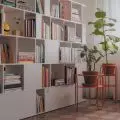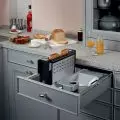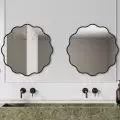The interview is from the 02/2024 issue of A&B
Former slaughterhouse vs. contemporary art gallery. Public building vs. public space. A brownfield site vs. a park. Dirty brick vs. movable walls. Lime plaster vs. microcement. None of these statements contradict each other; instead, they show how the old with the new, the interior with the exterior, are one cohesive whole. We talk about the design of the PLATO Contemporary Art Gallery in Ostrava with its main author, architect Robert Konieczny of the KWK Promes office.
Izabela Kutyla:Congratulations on so many awards and prizes for the PLATO Gallery project. These include, among others, the National Prize BigMat International Architecture Award "23, Česká Cena za Architekturu in the category Reconstruction 2023. The project is appreciated by both conservators and users. What conservation approach allowed this success?
Robert Konieczny: Thank you. I am especially happy about the architectural Oscar, an award presented by the conservation community in the Czech Republic. This is an important signal to other conservators, who often struggle with the problem of interfering new fabric into an existing structure and defining its principles. This is especially important now, at a time of climate challenges, when we know for sure that it is necessary to reach out and use the old fabric. Of course, this is not always possible. It is also often the case that we come into contact with preservationists who block certain activities, treating these buildings as certain sanctities in which nothing can be changed anymore. This award was a signal that if you do it right, you don't have to be afraid of it, in fact the opposite.
Isabella:What makes PLATO Gallery unique?
Robert: The individual galleries have rotating walls, which when closed are an extension of the exhibition space, but when they open, the art on display can reach outside, into the space around the gallery, the urban space. This is what is most interesting about this building. This is what makes this building unique and so unusual that the people managing it have to learn it and understand the possibilities it gives them. It's not that obvious at all.
Isabella:We are dealing with a public building, which, once opened, becomes a public space, very open and accessible. What are the beginnings of this unusual gallery?
Robert: PLATO is a gallery that shows art that you won't see in very traditional galleries. There are also a lot of social activities taking place here. There is something going on all the time, which makes me extremely happy. Events are moving into the space around, which is what we wanted most.
Plato Gallery of Contemporary Art in Ostrava - Western elevation
Photo: Juliusz Sokolowski © KWK Promes
Izabela:Here the old intermingles with the new and the interior with the exterior. The green exterior is extremely important. However, this was not the original idea.
Robert: It wasn't. We originally planned a city square with a utility floor. Many things contributed to the change, including a report on the state of the climate that came out during the pandemic and the construction that had already begun. Another equally important aspect was that when we entered the competition, we didn't know the city all that well. As we worked, we got to know it better and better. We realized that this was the outskirts of the city and we needed to provide something more for the residents to draw them here, and an empty square would certainly not become a public forum in this location. So we created a place that combines an exhibition space with an attractive biodiverse park. There are greenery and water, and soon trees will provide shade. We also have underground retention tanks there to capture water during rainstorms, which is later used to water the plantings. We had to work this out in our own heads, and then fight for it. When a project is underway, it's not at all that simple to bring about change, especially if it's a public procurement. Fortunately, we were able to do it. We would also like the park around PLATO to be influenced by the gallery users and the artists invited there, which is already happening.
Isabella:This project was the subject of a competition. In every competition there are guidelines to be met. There is also an element or a set of them that allows you to win and appeals to the jury. What was it in this case?
Robert: Our work was so shocking to the jury that they initially thought it was unworkable, and that worked against us. For the jury it was a bit of science fiction. In this closed, international competition, three finalists were eventually selected, and we came in third place. Petr Hájek won with a relatively standard design. Second place was similar. The finalists were involved in a struggle over who would realize their vision. Hájek submitted an offer, which he later withdrew, not wanting to sign the contract. The other team failed to meet some formalities. We presented a reasonable offer, a reasonable time to prepare the project and a lot of comments on the contract, which was very dangerous. Unfortunately, by the fact that the winner did not make any comments on it, we lost the chance to make any changes to these provisions. After unsuccessful attempts to cooperate with the other teams, the City asked us to take on the task. We were very skeptical because of the provisions in the contract. There was a danger that one mistake would cause us to have to close the company.
Plato Gallery of Contemporary Art in Ostrava - Detail of the west facade - revolving door
Photo: Juliusz Sokolowski © KWK Promes
Izabela:Why did you take on this task?
Robert: I was tempted to do this project. Besides, we were the only ones left and the City insisted, asked us to take up this subject. They cared about saving the building, and so did we, of course. It was also impossible to announce another competition for political and budgetary reasons. And this building would have collapsed within two years without interference. The story is quite interesting, and the innovation a bit forced on the organizers, they got it as a gift.
Isabella:What seemed like science fiction turned out to be feasible.
Robert: We have a lot of experience in mobile architecture, we do a lot of such things. To all the critics who say that the Safe House is nothing cool, an antisocial building, and that houses shouldn't be built anymore: if we hadn't built it, and if we hadn't understood that mobile elements can create and change the space around the building, we wouldn't have opened up to such mobility in PLATO. PLATO is a public building that is extremely open to its surroundings. And the idea was created by a building that is associated with closure.
Isabella:What were the main architectural design considerations in the adaptation, especially in terms of form and materials?
Robert: We studied the history of the site very carefully. The result of these analyses, this historical investigation, is the current structure of the building. The building was built of brick, and its roofs had dark tar paper. Inside, for sanitary and hygienic reasons, all the walls were whitewashed with lime. We decided to stick to the following rule: we keep all things old in the original: brick on the outside and whitewashed walls (lime plaster) on the inside. The exception is the atrium, which used to be the exterior, so we left it in brick.
This building is very clear and structurally transparent. All the new elements are finished with microcement. This shows where there are these modern intrusions, traces of the present, both outside and inside the building. An industrial building with this kind of detailing looks almost like a Renaissance palace, they don't build like that now. One nod to history is the movable microcement walls, which preserve the old ornament of the wall. We did this for two reasons. Out of respect for history, to show how modernity fits into the monument. The second reason is purely architectural, engineering. The sections of the wall are not of equal thickness, they are wider from the bottom and taper towards the top. The easiest way to avoid strange details was to keep its thickness and ornaments.
Plato Contemporary Art Gallery in Ostrava - gallery interior - former courtyard and entrance area
Photo: Jakub Certowicz © KWK Promes
Izabela:How have you solved the function and communication inside the building?
Robert: You can enter from two sides: the city side and the railroad side. Inside there is a general space, which also often turns into an exhibition space. This is provided by six movable walls in the building, two of which belong to the entrance space, and also act as connectors to the outside. The communication itself is not complicated, everything can be circumvented overhead. Contrary to appearances, the user navigates through it quite intuitively. Visual information also helps.
Isabella:What principle, on the other hand, did you follow in terms of land use?
Robert: The slaughterhouse was surrounded by other industrial buildings, which have already been demolished. The entire park was built on the footprint of these buildings. Pedestrian routes, sprinkled with permeable gravel, were planned in place of the former spaces between the buildings. A simple solution that also shows what the former urban layout looked like.
Plato Contemporary Art Gallery in Ostrava - Old Slaughterhouse, 2018.
© KWK Promes
Isabella:Are there any remnants left of the industrial area?
Robert: Brick. This building was dirty, darkened, smeared with soot. It testified to the industrial history of this city. The preservationists' recommendation was, first of all, to fill the holes in the walls, battered by the large holes that had appeared over the years as the building deteriorated. Someone ran an auto repair shop there, for example, so they made a big hole in the facade for a gate. Another guideline was to clean the brick. We, however, saw it differently - the dirt of the brick testifies to the history of this city, and the holes were the perfect shortcut that makes it possible for art to get out of this building and go outside. When it's a possibility or an idea of the curators, if the weather is right, the building can draw people in or let the art out.
We managed to convince the conservators to do this, there were meetings, discussions, we explained every detail. In the end, together we formed a single team that kept an eye on the contractor selected in the tender. The conservator supervised which bricks to replace. Some came from the collapsed building, but there were not enough. The conservator came up with a special technology for dirtying them, patinating them. All this was done so that the individual bricks being replaced would fit the principle we had chosen.
Isabella:Is such a brick protected?
Robert: Yes, it is protected, however you have to be careful, you can get dirty. Architecture in this way also shows what our life (Ostrava is not far from Katowice) used to be like. It reminds us how harsh the conditions were and how contaminated the air was. Industry gave a toll not only on people, their lungs, but also on architecture. This is a vestige of times that are thankfully gone.
Isabella:You talk about the collapsed building. So what was the backstory behind the creation of PLATO Gallery?
Robert: The slaughterhouse dates back to the turn of the 20th century. It changed over time, grew. It is not a homogeneous building, as the plan and elevations show. The part of the building that collapsed - the newest one - came from the interwar period, and was founded on very unstable ground. This is a surprising situation. Suddenly part of it just collapsed, and part of it had to be demolished. At the time of construction, when we had the project ready, all the volume that was included there was needed. What now? Recreate it in brick? We decided to stick to our principle, and this concrete part is precisely the consequence of the design assumption: if we recreate, we use contemporary materials, finish with micro-cement while preserving the old ornamentation. This part of the building has no windows, they were not needed, there are exhibition halls that do not require natural light. On the facade you can only see the drawing of the windows. In the rest of the building, we tinted the windows using screen printing. It's a kind of ceramic print that, on the one hand, refers to the nailed-down windows, and on the other hand, allows to shade the exhibition halls.
Plato Gallery of Contemporary Art in Ostrava - South elevation.
Photo: Juliusz Sokolowski © KWK Promes
Isabella:What other challenges or compromises came up during the construction process?
Robert: I am not willing to compromise. If any arise, it is only one that does not destroy the idea of the project. The roofs were such a case. They had deteriorated so much that in places you could see the sky overhead. We wondered whether to make them dark, as in the original concept, or according to the chosen principle that we make everything new out of microcement. Equally important was that we didn't want to create another heat island.
Dark roofing paper causes a lot of heat buildup, and the temperature around it rises significantly, so we used a gray membrane. These are design decisions that came out of a rational view of the modern age. The message coming out of this project is that even when we design something, even when it is already under construction, what is not fully built can be improved, made better.
The project of the Breakthroughs Dialogue Center in Szczecin, on the other hand, shows that even when something already exists and if you want to, you can still improve it. I am particularly proud of this. There we are introducing new greenery, and thus shade, without destroying a well-functioning public space. And all this a few years after the facility was handed over.
Isabella:We are not made of concrete, we can revise our approach.
Robert: Our knowledge is increasing, our perspective is changing. If we can, let's react.
Plato Contemporary Art Gallery in Ostrava - Interior of the gallery.
Photo: Lucia Deveckova © KWK Promes
Izabela:You are developing a variety of projects - new fabric, adaptation. Which is more challenging?
Robert: It depends. The adaptation of PLATO was a very big challenge. Tilted building, micropiles, leveling it, saving walls that had nothing left to hold on to. An extremely complicated project. New buildings can also be a difficult experience.
We are now looking for new ways when it comes to designing or operating buildings. It's obvious that if you can wisely preserve the existing fabric, it's worth doing, rather than building from scratch. There are more and more such projects, and I think we should all look at it that way. But everything with common sense. Sometimes saving the old fabric is so difficult and so energy-intensive that it's better to build from scratch.
Isabella:What is KWK Promes currently working on?
Robert: One of the projects is the redevelopment of a former cloth factory in the Czech city of Přibor into housing for young people who are fleeing the city. The city has potential, living and housing conditions need to be improved. This project is the stuff of good housing. There will be small square meters, but if they are well designed, it is possible to live nicely in them. That's how you know a good architect: how he handles the floor plans of apartments, especially small ones. There every centimeter counts, every wall. It's not spectacular, but it's also very interesting and rewarding.
Isabella:I'm keeping my fingers crossed for your next realizations. Thank you for the interview.













































